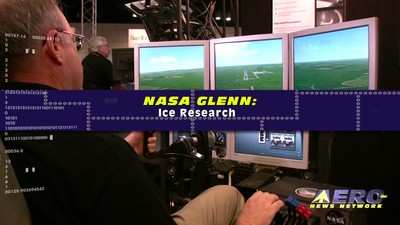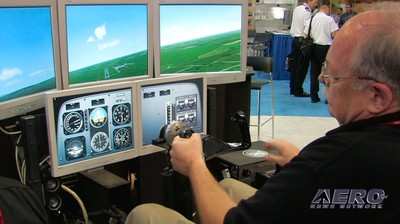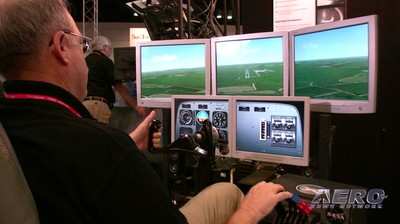Thu, Oct 09, 2008
Late last year, ANN's Aero-TV crews spied a truly marvelous
piece of flight simulation technology... NASA Glenn's icing flight
training simulator. Demonstrated at the Interservice/Industry
Training, Simulation and Education Conference (I/ITSEC), we were
incredibly impressed at the apparent accuracy of the model (ANN's
Jim Campbell has plenty of Twin Otter time -- the aircraft used in
the icing encounter sim model -- and knows only too well that the
icing behavior they displayed is what he has experienced,
personally, in real icing conditions).

The high-fidelity simulation model for icing effects flight
training was developed from wind tunnel data for the DeHavilland
DHC-6 Twin Otter aircraft. First, a flight model of the un-iced
airplane was developed and then modifications were generated to
model the icing conditions.
The models were validated against data records from the NASA
Twin Otter Icing Research flight test program with only minimal
refinements being required. The goals of this program were to
demonstrate the effectiveness of such a simulator for training
pilots to recognize and recover from icing situations and to
establish a process for modeling icing effects to be used for
future training devices.

NASA notes that 'Developing flight simulators that incorporate
the aerodynamic effects of icing will provide a critical element in
pilot training programs by giving pilots a pre-exposure of
icing-related hazards, such as ice-contaminated roll upset or
tailplane stall. Integrating these effects into training flight
simulators will provide an accurate representation of scenarios to
develop pilot skills in unusual attitudes and loss-of-control
events that may result from airframe icing.'
ANN first saw this technology demonstrated at I/ITSEC, an
organization that promotes cooperation among the Armed Services,
Industry, Academia and various Government agencies in pursuit of
improved training and education programs, identification of common
training issues and development of multiservice programs. The 2008
rendition of this event comes this December 1-4, 2008.

More News
With Testing Soon Complete, Launch Preparations Begin in Earnest Sierra Space's Dream Chaser has been put through the wringer at NASA's Glenn Armstrong Test Facility in Ohio, but w>[...]
Takeoff Roll The process whereby an aircraft is aligned with the runway centerline and the aircraft is moving with the intent to take off. For helicopters, this pertains to the act>[...]
“We’re proud of the hard work that went into receiving this validation, and it will be a welcome relief to our customers in the European Union. We couldn’t be mor>[...]
"Aircraft Spruce is pleased to announce the acquisition of the parts distribution operations of Wag-Aero. Wag-Aero was founded in the 1960’s by Dick and Bobbie Wagner in the >[...]
IDENT Feature The special feature in the Air Traffic Control Radar Beacon System (ATCRBS) equipment. It is used to immediately distinguish one displayed beacon target from other be>[...]
 Sierra Space Repositions Dream Chaser for First Mission
Sierra Space Repositions Dream Chaser for First Mission ANN's Daily Aero-Term (05.10.24): Takeoff Roll
ANN's Daily Aero-Term (05.10.24): Takeoff Roll Aero-News: Quote of the Day (05.10.24)
Aero-News: Quote of the Day (05.10.24) Aero-News: Quote of the Day (05.11.24)
Aero-News: Quote of the Day (05.11.24) ANN's Daily Aero-Term (05.11.24): IDENT Feature
ANN's Daily Aero-Term (05.11.24): IDENT Feature





